Pharmacology Report: Drug X Treatment of Metabolic Syndrome in Rats
VerifiedAdded on 2022/09/18
|8
|2383
|33
Report
AI Summary
This pharmacology report details a study investigating the efficacy of Drug X in treating metabolic syndrome induced by a high-fat diet in Sprague-Dawley rats. The study involved three groups: normal control, disease control, and treatment control. Rats in the disease and treatment groups were fed a high-fat diet for 10 weeks, while the treatment group received Drug X for the final 4 weeks. The results indicated that Drug X significantly reduced glucose, insulin, cholesterol, and triglyceride levels in the treatment group compared to the disease control group, suggesting its potential in managing metabolic syndrome. The report includes a detailed introduction to metabolic syndrome, the methods used, the results obtained, a discussion of the findings, and references to relevant literature. The study highlights the usefulness of high-fat diet-induced rodent models for evaluating potential treatments for metabolic syndrome.

Pharmacology Report
1
1
Paraphrase This Document
Need a fresh take? Get an instant paraphrase of this document with our AI Paraphraser
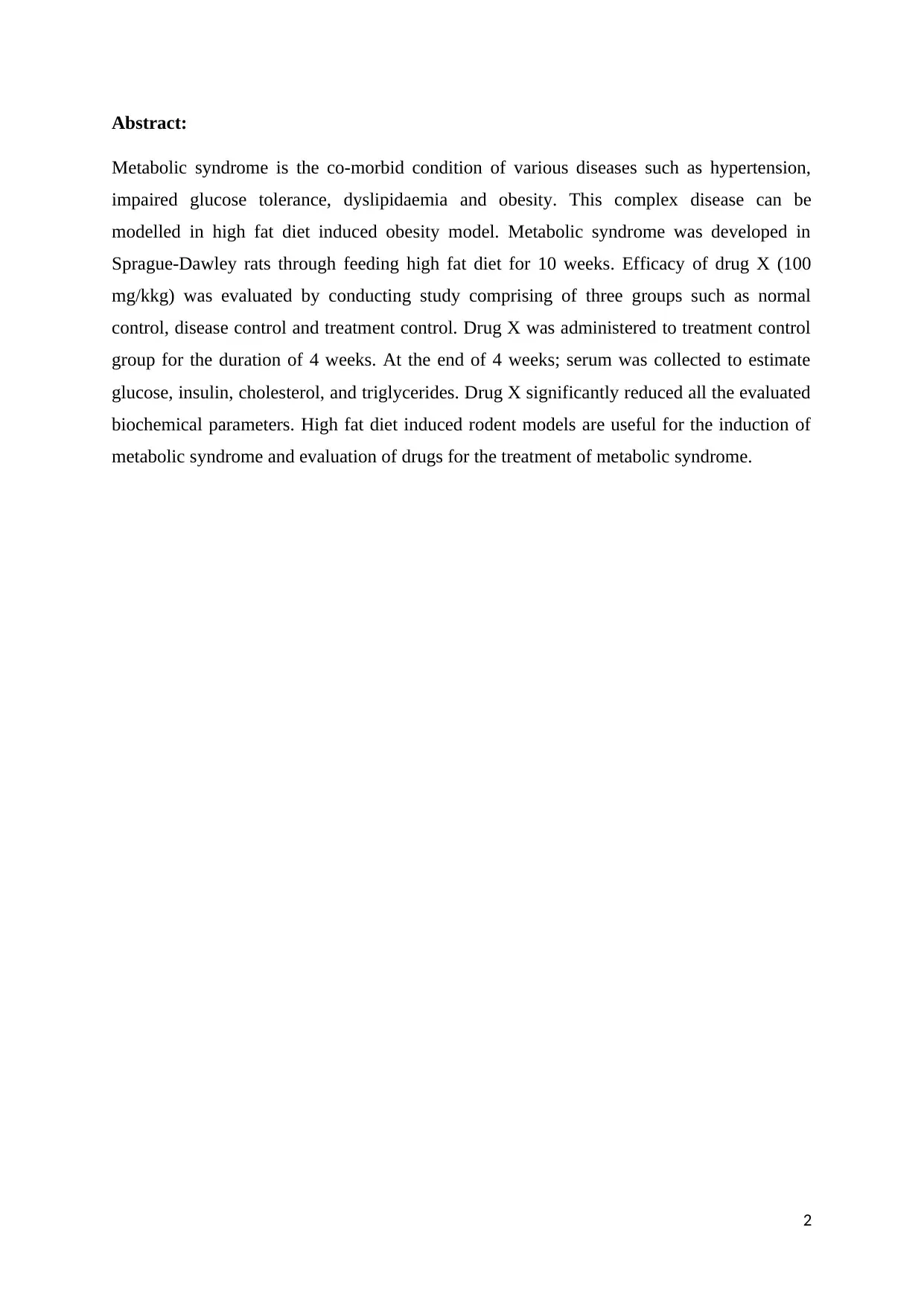
Abstract:
Metabolic syndrome is the co-morbid condition of various diseases such as hypertension,
impaired glucose tolerance, dyslipidaemia and obesity. This complex disease can be
modelled in high fat diet induced obesity model. Metabolic syndrome was developed in
Sprague-Dawley rats through feeding high fat diet for 10 weeks. Efficacy of drug X (100
mg/kkg) was evaluated by conducting study comprising of three groups such as normal
control, disease control and treatment control. Drug X was administered to treatment control
group for the duration of 4 weeks. At the end of 4 weeks; serum was collected to estimate
glucose, insulin, cholesterol, and triglycerides. Drug X significantly reduced all the evaluated
biochemical parameters. High fat diet induced rodent models are useful for the induction of
metabolic syndrome and evaluation of drugs for the treatment of metabolic syndrome.
2
Metabolic syndrome is the co-morbid condition of various diseases such as hypertension,
impaired glucose tolerance, dyslipidaemia and obesity. This complex disease can be
modelled in high fat diet induced obesity model. Metabolic syndrome was developed in
Sprague-Dawley rats through feeding high fat diet for 10 weeks. Efficacy of drug X (100
mg/kkg) was evaluated by conducting study comprising of three groups such as normal
control, disease control and treatment control. Drug X was administered to treatment control
group for the duration of 4 weeks. At the end of 4 weeks; serum was collected to estimate
glucose, insulin, cholesterol, and triglycerides. Drug X significantly reduced all the evaluated
biochemical parameters. High fat diet induced rodent models are useful for the induction of
metabolic syndrome and evaluation of drugs for the treatment of metabolic syndrome.
2

Table of Contents
Introduction…………………………………………………4
Methods……………………………………………………..4
Results………………………………………………………5
Discussion…………………………………………………...6
References…………………………………………………...8
3
Introduction…………………………………………………4
Methods……………………………………………………..4
Results………………………………………………………5
Discussion…………………………………………………...6
References…………………………………………………...8
3
⊘ This is a preview!⊘
Do you want full access?
Subscribe today to unlock all pages.

Trusted by 1+ million students worldwide
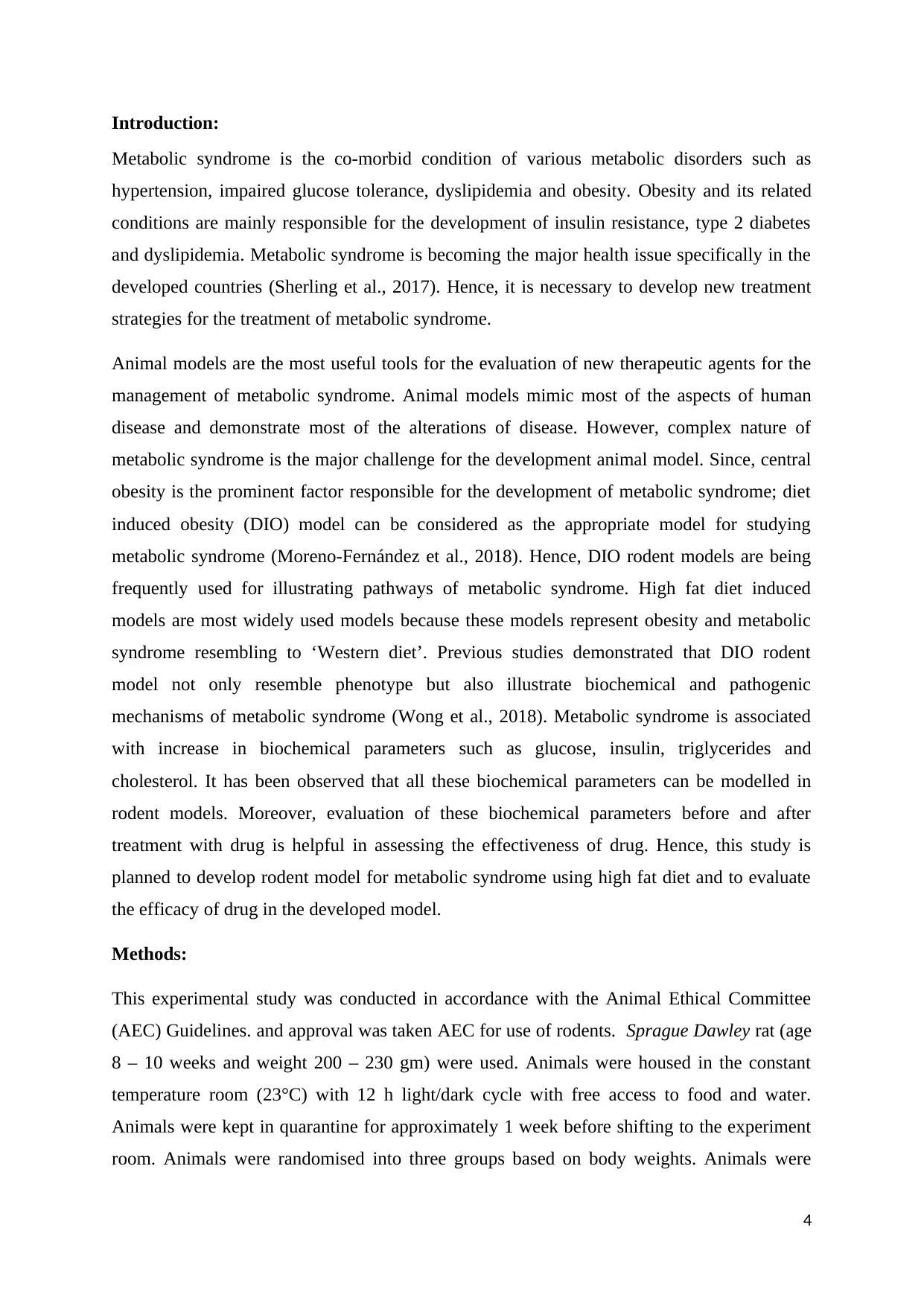
Introduction:
Metabolic syndrome is the co-morbid condition of various metabolic disorders such as
hypertension, impaired glucose tolerance, dyslipidemia and obesity. Obesity and its related
conditions are mainly responsible for the development of insulin resistance, type 2 diabetes
and dyslipidemia. Metabolic syndrome is becoming the major health issue specifically in the
developed countries (Sherling et al., 2017). Hence, it is necessary to develop new treatment
strategies for the treatment of metabolic syndrome.
Animal models are the most useful tools for the evaluation of new therapeutic agents for the
management of metabolic syndrome. Animal models mimic most of the aspects of human
disease and demonstrate most of the alterations of disease. However, complex nature of
metabolic syndrome is the major challenge for the development animal model. Since, central
obesity is the prominent factor responsible for the development of metabolic syndrome; diet
induced obesity (DIO) model can be considered as the appropriate model for studying
metabolic syndrome (Moreno-Fernández et al., 2018). Hence, DIO rodent models are being
frequently used for illustrating pathways of metabolic syndrome. High fat diet induced
models are most widely used models because these models represent obesity and metabolic
syndrome resembling to ‘Western diet’. Previous studies demonstrated that DIO rodent
model not only resemble phenotype but also illustrate biochemical and pathogenic
mechanisms of metabolic syndrome (Wong et al., 2018). Metabolic syndrome is associated
with increase in biochemical parameters such as glucose, insulin, triglycerides and
cholesterol. It has been observed that all these biochemical parameters can be modelled in
rodent models. Moreover, evaluation of these biochemical parameters before and after
treatment with drug is helpful in assessing the effectiveness of drug. Hence, this study is
planned to develop rodent model for metabolic syndrome using high fat diet and to evaluate
the efficacy of drug in the developed model.
Methods:
This experimental study was conducted in accordance with the Animal Ethical Committee
(AEC) Guidelines. and approval was taken AEC for use of rodents. Sprague Dawley rat (age
8 – 10 weeks and weight 200 – 230 gm) were used. Animals were housed in the constant
temperature room (23°C) with 12 h light/dark cycle with free access to food and water.
Animals were kept in quarantine for approximately 1 week before shifting to the experiment
room. Animals were randomised into three groups based on body weights. Animals were
4
Metabolic syndrome is the co-morbid condition of various metabolic disorders such as
hypertension, impaired glucose tolerance, dyslipidemia and obesity. Obesity and its related
conditions are mainly responsible for the development of insulin resistance, type 2 diabetes
and dyslipidemia. Metabolic syndrome is becoming the major health issue specifically in the
developed countries (Sherling et al., 2017). Hence, it is necessary to develop new treatment
strategies for the treatment of metabolic syndrome.
Animal models are the most useful tools for the evaluation of new therapeutic agents for the
management of metabolic syndrome. Animal models mimic most of the aspects of human
disease and demonstrate most of the alterations of disease. However, complex nature of
metabolic syndrome is the major challenge for the development animal model. Since, central
obesity is the prominent factor responsible for the development of metabolic syndrome; diet
induced obesity (DIO) model can be considered as the appropriate model for studying
metabolic syndrome (Moreno-Fernández et al., 2018). Hence, DIO rodent models are being
frequently used for illustrating pathways of metabolic syndrome. High fat diet induced
models are most widely used models because these models represent obesity and metabolic
syndrome resembling to ‘Western diet’. Previous studies demonstrated that DIO rodent
model not only resemble phenotype but also illustrate biochemical and pathogenic
mechanisms of metabolic syndrome (Wong et al., 2018). Metabolic syndrome is associated
with increase in biochemical parameters such as glucose, insulin, triglycerides and
cholesterol. It has been observed that all these biochemical parameters can be modelled in
rodent models. Moreover, evaluation of these biochemical parameters before and after
treatment with drug is helpful in assessing the effectiveness of drug. Hence, this study is
planned to develop rodent model for metabolic syndrome using high fat diet and to evaluate
the efficacy of drug in the developed model.
Methods:
This experimental study was conducted in accordance with the Animal Ethical Committee
(AEC) Guidelines. and approval was taken AEC for use of rodents. Sprague Dawley rat (age
8 – 10 weeks and weight 200 – 230 gm) were used. Animals were housed in the constant
temperature room (23°C) with 12 h light/dark cycle with free access to food and water.
Animals were kept in quarantine for approximately 1 week before shifting to the experiment
room. Animals were randomised into three groups based on body weights. Animals were
4
Paraphrase This Document
Need a fresh take? Get an instant paraphrase of this document with our AI Paraphraser
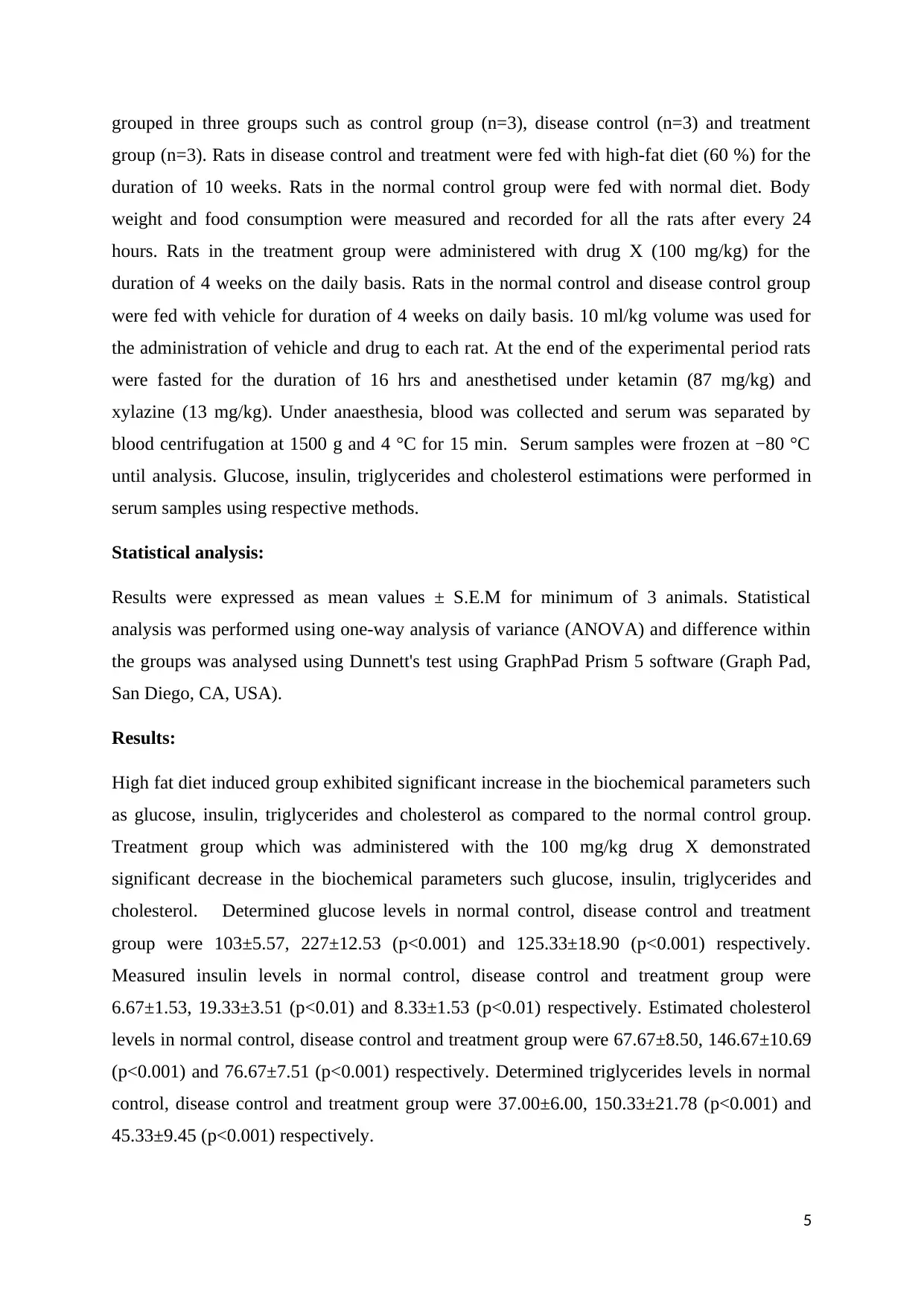
grouped in three groups such as control group (n=3), disease control (n=3) and treatment
group (n=3). Rats in disease control and treatment were fed with high-fat diet (60 %) for the
duration of 10 weeks. Rats in the normal control group were fed with normal diet. Body
weight and food consumption were measured and recorded for all the rats after every 24
hours. Rats in the treatment group were administered with drug X (100 mg/kg) for the
duration of 4 weeks on the daily basis. Rats in the normal control and disease control group
were fed with vehicle for duration of 4 weeks on daily basis. 10 ml/kg volume was used for
the administration of vehicle and drug to each rat. At the end of the experimental period rats
were fasted for the duration of 16 hrs and anesthetised under ketamin (87 mg/kg) and
xylazine (13 mg/kg). Under anaesthesia, blood was collected and serum was separated by
blood centrifugation at 1500 g and 4 °C for 15 min. Serum samples were frozen at −80 °C
until analysis. Glucose, insulin, triglycerides and cholesterol estimations were performed in
serum samples using respective methods.
Statistical analysis:
Results were expressed as mean values ± S.E.M for minimum of 3 animals. Statistical
analysis was performed using one-way analysis of variance (ANOVA) and difference within
the groups was analysed using Dunnett's test using GraphPad Prism 5 software (Graph Pad,
San Diego, CA, USA).
Results:
High fat diet induced group exhibited significant increase in the biochemical parameters such
as glucose, insulin, triglycerides and cholesterol as compared to the normal control group.
Treatment group which was administered with the 100 mg/kg drug X demonstrated
significant decrease in the biochemical parameters such glucose, insulin, triglycerides and
cholesterol. Determined glucose levels in normal control, disease control and treatment
group were 103±5.57, 227±12.53 (p˂0.001) and 125.33±18.90 (p˂0.001) respectively.
Measured insulin levels in normal control, disease control and treatment group were
6.67±1.53, 19.33±3.51 (p˂0.01) and 8.33±1.53 (p˂0.01) respectively. Estimated cholesterol
levels in normal control, disease control and treatment group were 67.67±8.50, 146.67±10.69
(p˂0.001) and 76.67±7.51 (p˂0.001) respectively. Determined triglycerides levels in normal
control, disease control and treatment group were 37.00±6.00, 150.33±21.78 (p˂0.001) and
45.33±9.45 (p˂0.001) respectively.
5
group (n=3). Rats in disease control and treatment were fed with high-fat diet (60 %) for the
duration of 10 weeks. Rats in the normal control group were fed with normal diet. Body
weight and food consumption were measured and recorded for all the rats after every 24
hours. Rats in the treatment group were administered with drug X (100 mg/kg) for the
duration of 4 weeks on the daily basis. Rats in the normal control and disease control group
were fed with vehicle for duration of 4 weeks on daily basis. 10 ml/kg volume was used for
the administration of vehicle and drug to each rat. At the end of the experimental period rats
were fasted for the duration of 16 hrs and anesthetised under ketamin (87 mg/kg) and
xylazine (13 mg/kg). Under anaesthesia, blood was collected and serum was separated by
blood centrifugation at 1500 g and 4 °C for 15 min. Serum samples were frozen at −80 °C
until analysis. Glucose, insulin, triglycerides and cholesterol estimations were performed in
serum samples using respective methods.
Statistical analysis:
Results were expressed as mean values ± S.E.M for minimum of 3 animals. Statistical
analysis was performed using one-way analysis of variance (ANOVA) and difference within
the groups was analysed using Dunnett's test using GraphPad Prism 5 software (Graph Pad,
San Diego, CA, USA).
Results:
High fat diet induced group exhibited significant increase in the biochemical parameters such
as glucose, insulin, triglycerides and cholesterol as compared to the normal control group.
Treatment group which was administered with the 100 mg/kg drug X demonstrated
significant decrease in the biochemical parameters such glucose, insulin, triglycerides and
cholesterol. Determined glucose levels in normal control, disease control and treatment
group were 103±5.57, 227±12.53 (p˂0.001) and 125.33±18.90 (p˂0.001) respectively.
Measured insulin levels in normal control, disease control and treatment group were
6.67±1.53, 19.33±3.51 (p˂0.01) and 8.33±1.53 (p˂0.01) respectively. Estimated cholesterol
levels in normal control, disease control and treatment group were 67.67±8.50, 146.67±10.69
(p˂0.001) and 76.67±7.51 (p˂0.001) respectively. Determined triglycerides levels in normal
control, disease control and treatment group were 37.00±6.00, 150.33±21.78 (p˂0.001) and
45.33±9.45 (p˂0.001) respectively.
5
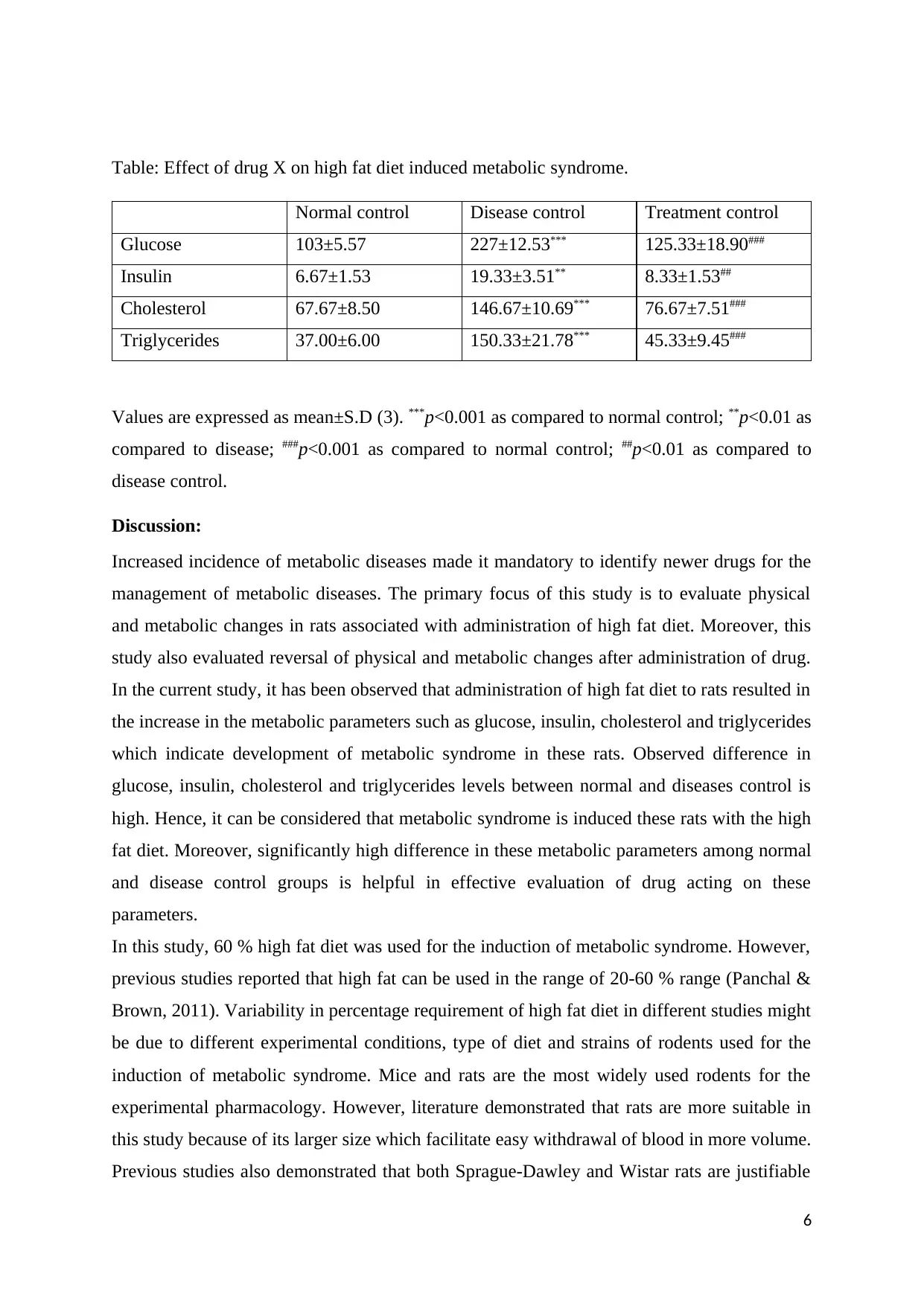
Table: Effect of drug X on high fat diet induced metabolic syndrome.
Normal control Disease control Treatment control
Glucose 103±5.57 227±12.53*** 125.33±18.90###
Insulin 6.67±1.53 19.33±3.51** 8.33±1.53##
Cholesterol 67.67±8.50 146.67±10.69*** 76.67±7.51###
Triglycerides 37.00±6.00 150.33±21.78*** 45.33±9.45###
Values are expressed as mean±S.D (3). ***p˂0.001 as compared to normal control; **p˂0.01 as
compared to disease; ###p˂0.001 as compared to normal control; ##p˂0.01 as compared to
disease control.
Discussion:
Increased incidence of metabolic diseases made it mandatory to identify newer drugs for the
management of metabolic diseases. The primary focus of this study is to evaluate physical
and metabolic changes in rats associated with administration of high fat diet. Moreover, this
study also evaluated reversal of physical and metabolic changes after administration of drug.
In the current study, it has been observed that administration of high fat diet to rats resulted in
the increase in the metabolic parameters such as glucose, insulin, cholesterol and triglycerides
which indicate development of metabolic syndrome in these rats. Observed difference in
glucose, insulin, cholesterol and triglycerides levels between normal and diseases control is
high. Hence, it can be considered that metabolic syndrome is induced these rats with the high
fat diet. Moreover, significantly high difference in these metabolic parameters among normal
and disease control groups is helpful in effective evaluation of drug acting on these
parameters.
In this study, 60 % high fat diet was used for the induction of metabolic syndrome. However,
previous studies reported that high fat can be used in the range of 20-60 % range (Panchal &
Brown, 2011). Variability in percentage requirement of high fat diet in different studies might
be due to different experimental conditions, type of diet and strains of rodents used for the
induction of metabolic syndrome. Mice and rats are the most widely used rodents for the
experimental pharmacology. However, literature demonstrated that rats are more suitable in
this study because of its larger size which facilitate easy withdrawal of blood in more volume.
Previous studies also demonstrated that both Sprague‐Dawley and Wistar rats are justifiable
6
Normal control Disease control Treatment control
Glucose 103±5.57 227±12.53*** 125.33±18.90###
Insulin 6.67±1.53 19.33±3.51** 8.33±1.53##
Cholesterol 67.67±8.50 146.67±10.69*** 76.67±7.51###
Triglycerides 37.00±6.00 150.33±21.78*** 45.33±9.45###
Values are expressed as mean±S.D (3). ***p˂0.001 as compared to normal control; **p˂0.01 as
compared to disease; ###p˂0.001 as compared to normal control; ##p˂0.01 as compared to
disease control.
Discussion:
Increased incidence of metabolic diseases made it mandatory to identify newer drugs for the
management of metabolic diseases. The primary focus of this study is to evaluate physical
and metabolic changes in rats associated with administration of high fat diet. Moreover, this
study also evaluated reversal of physical and metabolic changes after administration of drug.
In the current study, it has been observed that administration of high fat diet to rats resulted in
the increase in the metabolic parameters such as glucose, insulin, cholesterol and triglycerides
which indicate development of metabolic syndrome in these rats. Observed difference in
glucose, insulin, cholesterol and triglycerides levels between normal and diseases control is
high. Hence, it can be considered that metabolic syndrome is induced these rats with the high
fat diet. Moreover, significantly high difference in these metabolic parameters among normal
and disease control groups is helpful in effective evaluation of drug acting on these
parameters.
In this study, 60 % high fat diet was used for the induction of metabolic syndrome. However,
previous studies reported that high fat can be used in the range of 20-60 % range (Panchal &
Brown, 2011). Variability in percentage requirement of high fat diet in different studies might
be due to different experimental conditions, type of diet and strains of rodents used for the
induction of metabolic syndrome. Mice and rats are the most widely used rodents for the
experimental pharmacology. However, literature demonstrated that rats are more suitable in
this study because of its larger size which facilitate easy withdrawal of blood in more volume.
Previous studies also demonstrated that both Sprague‐Dawley and Wistar rats are justifiable
6
⊘ This is a preview!⊘
Do you want full access?
Subscribe today to unlock all pages.

Trusted by 1+ million students worldwide

for the high fat diet induced metabolic syndrome model (Kumar et al., 2016). Hence,
Sprague-Dawley rats were used in this study.
High fat diet is known to produce impairment in the insulin sensitivity and increase the
hepatic glucose production. Previous studies also indicated that high diet consumption in
human is responsible for the increase on the postprandial hyperglycaemia. Consequently,
these is increase in the requirement of insulin to compensate increased glucose levels
(Gormsen et al., 2011). Similar results were observed in our study also. Hence, this model
can be considered as mimic to the human metabolic syndrome. In the previous studies it has
been observed that there is increase in triglycerides and cholesterol levels after administration
of high fat diet as compared to the normal diet. Progression of disease in such conditions is
considered resemblance to the metabolic disease. Factors responsible for the increase in the
triglycerides levels are oxidative stress and insulin resistance (Lozano et al., 2019; Kaprinay
et al., 2016).
Experimental drug-X can be considered as effective for the metabolic diseases because this
drug proved beneficial in reducing diverse biochemical parametres such as glucose, insulin,
triglycerides and cholesterol. It indicates drug X might act on different biological targets.
Drugs acting on the different biological targets can be considered as the most effective drugs
for the treatment of metabolic disease because it is a multifactorial disease. Moreover,
metabolic disease affects various organs such as liver, pancreas, circulatory organs and
kidney. Drug X can be considered as the significant development in the drug research for
metabolic diseases because till date there is scarcity of drugs which can exhibit its effect on
multiple biochemical parameters and multiple targets. However, it is necessary to evaluate
effect of drug X on other metabolic parameters to confirm its wider applicability. High fat
diet can successfully develop phenotypes such as obesity, diabetes, hyperlipidaemia,
atherosclerosis and hypertension. Hence, it would be wise to evaluate the effect of drug X on
the body weight and blood pressure. Moreover, other biochemical parameters such as serum
fatty acids, leptin, adiponectin and resistin should be evaluated in the animal models of
metabolic syndrome (Aydin et al., 2014; Senaphan et al., 2015). In summary, high fat diet
induced rodent models are useful for the induction of metabolic syndrome and evaluation of
drugs for the treatment of metabolic syndrome.
7
Sprague-Dawley rats were used in this study.
High fat diet is known to produce impairment in the insulin sensitivity and increase the
hepatic glucose production. Previous studies also indicated that high diet consumption in
human is responsible for the increase on the postprandial hyperglycaemia. Consequently,
these is increase in the requirement of insulin to compensate increased glucose levels
(Gormsen et al., 2011). Similar results were observed in our study also. Hence, this model
can be considered as mimic to the human metabolic syndrome. In the previous studies it has
been observed that there is increase in triglycerides and cholesterol levels after administration
of high fat diet as compared to the normal diet. Progression of disease in such conditions is
considered resemblance to the metabolic disease. Factors responsible for the increase in the
triglycerides levels are oxidative stress and insulin resistance (Lozano et al., 2019; Kaprinay
et al., 2016).
Experimental drug-X can be considered as effective for the metabolic diseases because this
drug proved beneficial in reducing diverse biochemical parametres such as glucose, insulin,
triglycerides and cholesterol. It indicates drug X might act on different biological targets.
Drugs acting on the different biological targets can be considered as the most effective drugs
for the treatment of metabolic disease because it is a multifactorial disease. Moreover,
metabolic disease affects various organs such as liver, pancreas, circulatory organs and
kidney. Drug X can be considered as the significant development in the drug research for
metabolic diseases because till date there is scarcity of drugs which can exhibit its effect on
multiple biochemical parameters and multiple targets. However, it is necessary to evaluate
effect of drug X on other metabolic parameters to confirm its wider applicability. High fat
diet can successfully develop phenotypes such as obesity, diabetes, hyperlipidaemia,
atherosclerosis and hypertension. Hence, it would be wise to evaluate the effect of drug X on
the body weight and blood pressure. Moreover, other biochemical parameters such as serum
fatty acids, leptin, adiponectin and resistin should be evaluated in the animal models of
metabolic syndrome (Aydin et al., 2014; Senaphan et al., 2015). In summary, high fat diet
induced rodent models are useful for the induction of metabolic syndrome and evaluation of
drugs for the treatment of metabolic syndrome.
7
Paraphrase This Document
Need a fresh take? Get an instant paraphrase of this document with our AI Paraphraser
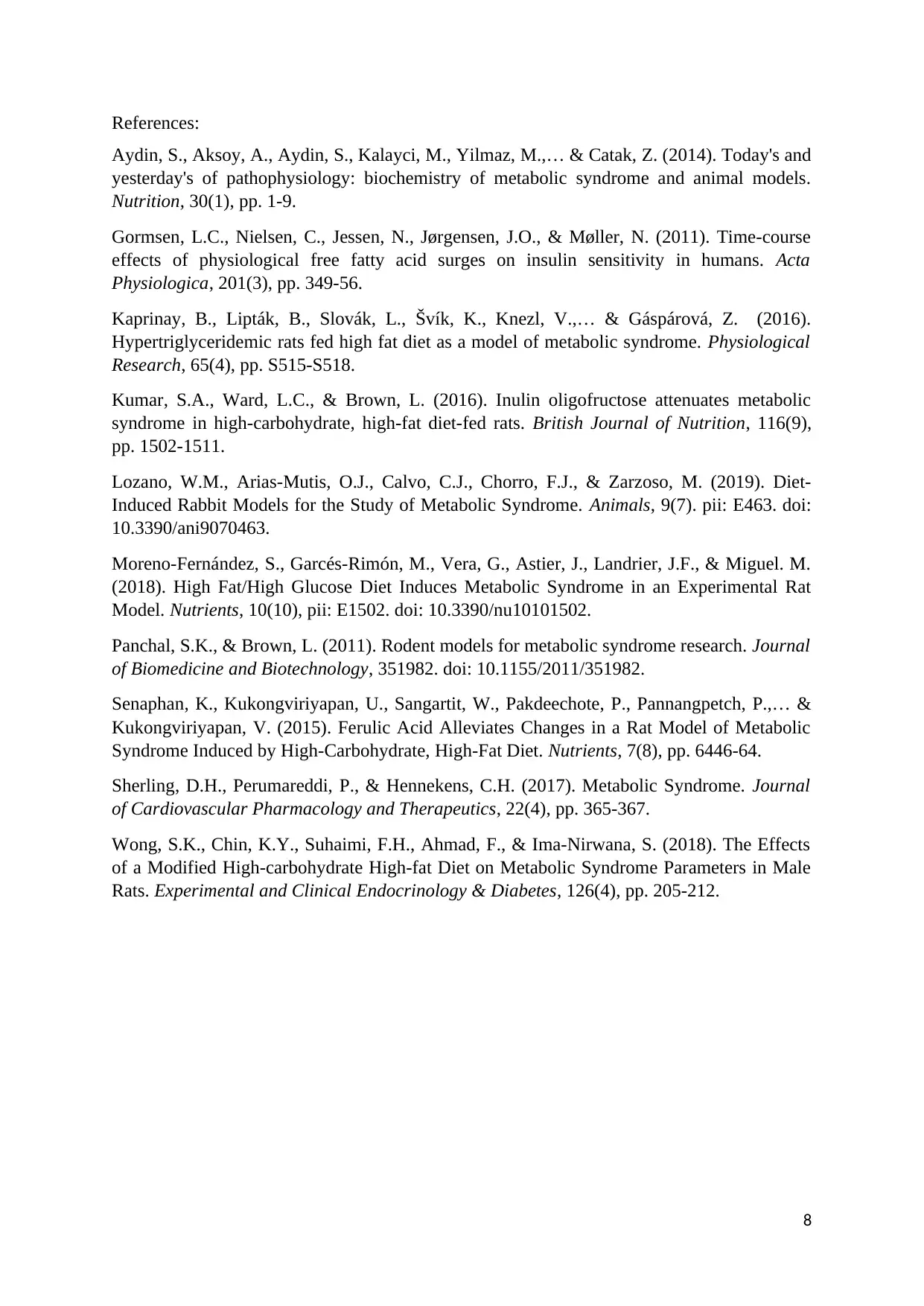
References:
Aydin, S., Aksoy, A., Aydin, S., Kalayci, M., Yilmaz, M.,… & Catak, Z. (2014). Today's and
yesterday's of pathophysiology: biochemistry of metabolic syndrome and animal models.
Nutrition, 30(1), pp. 1-9.
Gormsen, L.C., Nielsen, C., Jessen, N., Jørgensen, J.O., & Møller, N. (2011). Time-course
effects of physiological free fatty acid surges on insulin sensitivity in humans. Acta
Physiologica, 201(3), pp. 349-56.
Kaprinay, B., Lipták, B., Slovák, L., Švík, K., Knezl, V.,… & Gáspárová, Z. (2016).
Hypertriglyceridemic rats fed high fat diet as a model of metabolic syndrome. Physiological
Research, 65(4), pp. S515-S518.
Kumar, S.A., Ward, L.C., & Brown, L. (2016). Inulin oligofructose attenuates metabolic
syndrome in high-carbohydrate, high-fat diet-fed rats. British Journal of Nutrition, 116(9),
pp. 1502-1511.
Lozano, W.M., Arias-Mutis, O.J., Calvo, C.J., Chorro, F.J., & Zarzoso, M. (2019). Diet-
Induced Rabbit Models for the Study of Metabolic Syndrome. Animals, 9(7). pii: E463. doi:
10.3390/ani9070463.
Moreno-Fernández, S., Garcés-Rimón, M., Vera, G., Astier, J., Landrier, J.F., & Miguel. M.
(2018). High Fat/High Glucose Diet Induces Metabolic Syndrome in an Experimental Rat
Model. Nutrients, 10(10), pii: E1502. doi: 10.3390/nu10101502.
Panchal, S.K., & Brown, L. (2011). Rodent models for metabolic syndrome research. Journal
of Biomedicine and Biotechnology, 351982. doi: 10.1155/2011/351982.
Senaphan, K., Kukongviriyapan, U., Sangartit, W., Pakdeechote, P., Pannangpetch, P.,… &
Kukongviriyapan, V. (2015). Ferulic Acid Alleviates Changes in a Rat Model of Metabolic
Syndrome Induced by High-Carbohydrate, High-Fat Diet. Nutrients, 7(8), pp. 6446-64.
Sherling, D.H., Perumareddi, P., & Hennekens, C.H. (2017). Metabolic Syndrome. Journal
of Cardiovascular Pharmacology and Therapeutics, 22(4), pp. 365-367.
Wong, S.K., Chin, K.Y., Suhaimi, F.H., Ahmad, F., & Ima-Nirwana, S. (2018). The Effects
of a Modified High-carbohydrate High-fat Diet on Metabolic Syndrome Parameters in Male
Rats. Experimental and Clinical Endocrinology & Diabetes, 126(4), pp. 205-212.
8
Aydin, S., Aksoy, A., Aydin, S., Kalayci, M., Yilmaz, M.,… & Catak, Z. (2014). Today's and
yesterday's of pathophysiology: biochemistry of metabolic syndrome and animal models.
Nutrition, 30(1), pp. 1-9.
Gormsen, L.C., Nielsen, C., Jessen, N., Jørgensen, J.O., & Møller, N. (2011). Time-course
effects of physiological free fatty acid surges on insulin sensitivity in humans. Acta
Physiologica, 201(3), pp. 349-56.
Kaprinay, B., Lipták, B., Slovák, L., Švík, K., Knezl, V.,… & Gáspárová, Z. (2016).
Hypertriglyceridemic rats fed high fat diet as a model of metabolic syndrome. Physiological
Research, 65(4), pp. S515-S518.
Kumar, S.A., Ward, L.C., & Brown, L. (2016). Inulin oligofructose attenuates metabolic
syndrome in high-carbohydrate, high-fat diet-fed rats. British Journal of Nutrition, 116(9),
pp. 1502-1511.
Lozano, W.M., Arias-Mutis, O.J., Calvo, C.J., Chorro, F.J., & Zarzoso, M. (2019). Diet-
Induced Rabbit Models for the Study of Metabolic Syndrome. Animals, 9(7). pii: E463. doi:
10.3390/ani9070463.
Moreno-Fernández, S., Garcés-Rimón, M., Vera, G., Astier, J., Landrier, J.F., & Miguel. M.
(2018). High Fat/High Glucose Diet Induces Metabolic Syndrome in an Experimental Rat
Model. Nutrients, 10(10), pii: E1502. doi: 10.3390/nu10101502.
Panchal, S.K., & Brown, L. (2011). Rodent models for metabolic syndrome research. Journal
of Biomedicine and Biotechnology, 351982. doi: 10.1155/2011/351982.
Senaphan, K., Kukongviriyapan, U., Sangartit, W., Pakdeechote, P., Pannangpetch, P.,… &
Kukongviriyapan, V. (2015). Ferulic Acid Alleviates Changes in a Rat Model of Metabolic
Syndrome Induced by High-Carbohydrate, High-Fat Diet. Nutrients, 7(8), pp. 6446-64.
Sherling, D.H., Perumareddi, P., & Hennekens, C.H. (2017). Metabolic Syndrome. Journal
of Cardiovascular Pharmacology and Therapeutics, 22(4), pp. 365-367.
Wong, S.K., Chin, K.Y., Suhaimi, F.H., Ahmad, F., & Ima-Nirwana, S. (2018). The Effects
of a Modified High-carbohydrate High-fat Diet on Metabolic Syndrome Parameters in Male
Rats. Experimental and Clinical Endocrinology & Diabetes, 126(4), pp. 205-212.
8
1 out of 8
Your All-in-One AI-Powered Toolkit for Academic Success.
+13062052269
info@desklib.com
Available 24*7 on WhatsApp / Email
![[object Object]](/_next/static/media/star-bottom.7253800d.svg)
Unlock your academic potential
Copyright © 2020–2025 A2Z Services. All Rights Reserved. Developed and managed by ZUCOL.
